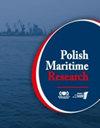Energy and Emission Quality Ranking of Newly Produced Low-Sulphur Marine Fuels
IF 2
3区 工程技术
Q2 ENGINEERING, MARINE
引用次数: 13
Abstract
Abstract The article describes the methodology of engine tests on new types of low-sulphur marine fuels in laboratory conditions in order to conduct a comprehensive assessment of their suitability for powering full-size marine engines. The innovativeness of the proposed solution consists of adapting the laboratory Diesel Engine Test Bed to carry out experimental tests using residual and alternative fuels so that it is possible to imitate the real operating conditions of the ship engine. The main aim of the research program was to assess the energy efficiency of six different low-sulphur marine fuels and their impact on the chemical emissivity of engine exhaust gases and air pollution with toxic and harmful chemical compounds. In order to achieve the research purpose formulated in this way, it was necessary to: (1) equip the constructed laboratory stand with highly specialised measuring equipment and (2) develop a technology for determining diagnostic parameters representing the basis for developing a ranking of the energy and emission quality of the tested marine fuels according to the proposed physical model. The model distinguishes 10 diagnostic parameters that, after normalisation, form two subsets of evaluation parameters - stimulant and destimulant. Determining their values made it possible to estimate a synthetic variable, according to which all the tested fuels were adjusted in the order from the “best” to the “worst”, in accordance with the adopted qualitative criteria of such an assessment. The results of the laboratory tests show that among the considered fuels, i.e., MDO, MGO, RMD 80/L, RMD 80/S, RME 180, and RMG 380 type, the best solution is to use MDO distillate fuel to power full-size marine engines. However, taking into account its high purchase price, a rational alternative decision is to choose RMG 380 type residual fuel, which ranks second in the ranking of the functional quality of the tested marine fuels.新生产的低硫船用燃料能源和排放质量排名
摘要本文介绍了在实验室条件下对新型低硫船用燃料进行发动机试验的方法,以全面评估其是否适合为全尺寸船用发动机提供动力。所提出的解决方案的创新性包括调整实验室柴油发动机试验台,使用残余燃料和替代燃料进行实验测试,从而可以模拟船舶发动机的真实运行条件。该研究项目的主要目的是评估六种不同低硫船用燃料的能源效率及其对发动机废气化学发射率和有毒有害化合物的空气污染的影响。为了实现以这种方式制定的研究目的,有必要:(1)为建造的实验室支架配备高度专业化的测量设备;(2)开发一种用于确定诊断参数的技术,该技术代表了根据拟议的物理模型对测试的船用燃料的能量和排放质量进行排名的基础。该模型区分了10个诊断参数,这些参数在归一化后形成了两个子集的评估参数——刺激性和非刺激性。通过确定它们的值,可以估计一个综合变量,根据该变量,根据所采用的此类评估的定性标准,按照从“最佳”到“最差”的顺序调整所有测试燃料。实验室试验结果表明,在所考虑的燃料中,即MDO、MGO、RMD 80/L、RMD 80/S、RME 180和RMG 380型,最好的解决方案是使用MDO馏分燃料为全尺寸船用发动机提供动力。然而,考虑到其高昂的购买价格,一个合理的替代决定是选择RMG 380型剩余燃料,该燃料在测试船用燃料的功能质量排名中排名第二。
本文章由计算机程序翻译,如有差异,请以英文原文为准。
求助全文
约1分钟内获得全文
求助全文
来源期刊

Polish Maritime Research
工程技术-工程:海洋
CiteScore
3.70
自引率
45.00%
发文量
20
审稿时长
>12 weeks
期刊介绍:
The scope of the journal covers selected issues related to all phases of product lifecycle and corresponding technologies for offshore floating and fixed structures and their components.
All researchers are invited to submit their original papers for peer review and publications related to methods of the design; production and manufacturing; maintenance and operational processes of such technical items as:
all types of vessels and their equipment,
fixed and floating offshore units and their components,
autonomous underwater vehicle (AUV) and remotely operated vehicle (ROV).
We welcome submissions from these fields in the following technical topics:
ship hydrodynamics: buoyancy and stability; ship resistance and propulsion, etc.,
structural integrity of ship and offshore unit structures: materials; welding; fatigue and fracture, etc.,
marine equipment: ship and offshore unit power plants: overboarding equipment; etc.
 求助内容:
求助内容: 应助结果提醒方式:
应助结果提醒方式:


